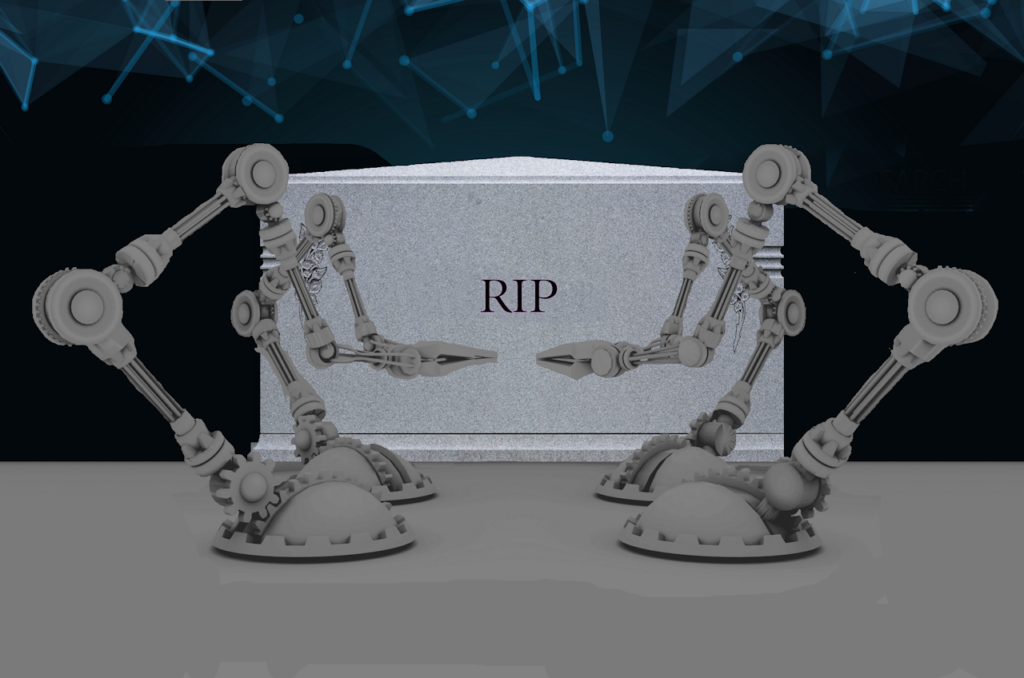In May 1897, rumors swirled among journalists that author Samuel Clemens (aka Mark Twain) was either dead or dying of a serious illness. Looking to confirm the rumors, the New York Journal’s Frank Marshall White contacted Clemens to see if there was any truth to the rumors. In a letter response, Clemens wrote, “The report of my death was an exaggeration.” Over the years, Clemens’ humorous response has been tweaked a bit and is often misquoted as “The report of my death has been [grossly or greatly] exaggerated.” Announcing the death of industrial age businesses may also be an exaggeration; however, most experts believe the death knells are sounding. Eugene Xiong, founder and Chairman of the Board of Foxit, asserts the recent pandemic demonstrated why industrial age businesses need to transform into digital enterprises. He explains, “Digital business is more than an opportunity for process improvement and cost efficiency. It can be a matter of survival and operational continuity when a crisis closes down traditional business channels. … It behooves all of us to begin migrating from a brick-and-mortar mentality to a digital business mindset whenever and wherever possible. … Companies would be wise to take a long, hard look at their internal and external workflows and customer engagement and fulfillment processes and create a plan to transform them to ensure both operational continuity and improved performance in future.”[1]
Martin Reeves, Chairman of Boston Consulting Group’s Henderson Institute, and Kevin Whitaker, Senior Director of Pricing Strategy and Data Science at Mojo, agree with Xiong. They write, “We live in an age where technology underpins growth and competitiveness. Seven of the world’s ten most valuable companies rely primarily on digital platforms, and digital natives are disrupting a broad range of industries. Most nondigital incumbents recognize the need for digital transformation and have embarked upon major change efforts.”[2] They caution, however, “Adopting technology is a means, not an end in itself. What, then, should be the aim of digital transformation? By being crystal clear about the goals and how to reach them, we can improve our odds of success.” In other words, don’t kill off your old business model unless you understand what the new business model looks like and have reasonable assurance it will succeed.
Killing Off Old Business Models Can be Traumatic
Thomas M. Siebel, Chairman and CEO of C3 AI, writes, “Comparing the human grieving process to what organizations go through when trying to digitally transform might sound like a stretch. And yet, while working with 200 or so large organizations over the past decade, I began to notice a pattern: strong parallels between Dr. Elisabeth Kübler-Ross’s classic book, On Death and Dying, and the journey organizations undergo while attempting to digitally transform. Kübler-Ross describes the grieving process in five stages: denial, anger, bargaining, depression, and acceptance. Those stages, it turns out, are uncomfortably close to what many CEOs and their teams have experienced.”[3] Change is hard. And, digital transformation is radical change. Tricia Wang, a self-described Tech Ethnographer & Sociologist, explains, “A lot of companies treat digital as if they are ‘doing digital’ — this is ‘digitization’ at its worst — as if it’s some checklist of things to do. It’s very transactional, and people are so busy doing digital they don’t even know WHY they are doing it in the first place! Whereas [some companies] embrace ‘being digital’ — this is ‘digital transformation’ at its best — it’s a total paradigm shift in the culture and operations — it’s not just about buying the latest digital tool, but about creating a new system, new cadence, new mindset.”[4]
It’s little wonder that people who have succeeded under an old business model would grieve at its passing. But, as Wang notes, digital transformation, at its best, does away with the old model and replaces it with “a new system, new cadence, new mindset.” Reeves and Whitaker call these new systems “biological organizations.” They explain, “Beyond merely executing today’s processes more efficiently, technology can also reshape how we sense and act on information. In particular, we can digitally transform our organization’s powers of perception and cognition, its ability to take collective action, and its ability to do so sustainably, in several ways.” They also note, “This approach may be uncomfortable to many leaders who have been trained to maximize short-run efficiency, not learning or social contribution.”
To get the most out of digital transformation efforts, Reeves and Whitaker suggest leaders should tap into this new biological paradigm by asking several pivotal questions. Those questions include: “Do our efforts expand the perceptive power of the organization? Do our efforts enhance the learning capability of the organization? Do our efforts create autonomous digital learning systems? Are the roles of humans and algorithms segmented to best effect? Is human cognition focused on more unique capabilities like imagination and empathy? Do our efforts help tap into the power of external ecosystems? Do our efforts help capitalize on emergent opportunities, or are they mainly plan-based? Have we reconceived the organization as a dynamic hybrid of technology and people, as opposed to a static human reporting structure? Are we using technology to increase the sustainability of the systems our enterprise relies upon? Does our company serve a clearly articulated social purpose?”
Easing the Trauma
To help ease the trauma associated with digital transformation Enterra Solutions® has developed the Enterra System of Intelligence®. This System ushers in a new era of AI-enabled management science by merging cutting-edge analytical techniques with a business’ data and knowledge to Sense, Think, Act, and Learn® on enterprise data to meet the changing needs of the market. Enterra’s System acts as central “brain” within an organization, ingesting diverse datasets, business logic and practices, and strategy, to uncover unique insights and generate autonomous recommendations across the enterprise at market speed. Insights and recommendations generated by the Enterra System of Intelligence are acted upon through deep integrations with an organization’s established systems of record and engagement, akin to how the brain (decision-making) and central nervous system (actions) interact within the human body. Enterra’s system uniquely learns the environmental reasons that recommendations are successful or not and persists that learning in its Ontologies and Generative AI knowledge bases to improve future insights and recommendations. The business application modules included in the Enterra System of Intelligence are:
• Enterra Consumer Insights Intelligence System™. This System allows clients to quantitatively uncover and logically understand the inter-relationships that lead to heightened consumer understanding, hyper-personalized product recommendations, and new product innovation.
• Enterra Revenue Growth Intelligence System™ (ERGIS™). ERGIS systemically performs holistic revenue growth optimization (including optimizing strategic and tactical pricing, trade promotion, trade architecture, price pack architecture, media mix, customer segmentation, and assortment).
• Enterra Demand and Supply Chain Intelligence System™. This System concurrently performs non-linear demand and supply planning optimization.
• Enterra Business WarGaming™. Business WarGaming enables organizations to leverage their data to make strategic decisions by anticipating the moves of their competitors and taking direct action to beat the competition, mitigate risk, navigate uncertainty, and maximize market opportunity. Part of Enterra Business WarGaming is the Enterra Global Insights and Decision Superiority System™ (EGIDS™) — powered by the Enterra Autonomous Decision Science™ platform — which can help business leaders rapidly explore a multitude of options and scenarios.
The Enterra System of Intelligence helps answer many of the questions posed by Reeves and Whitaker.
Concluding Thoughts
Habeeb Mahaboob, a Global Managing Consultant at Tech Mahindra, asserts, “Companies have been talking about and acting on the concept of business transformation for many years. Unfortunately, most of them still have not achieved the full benefits of this transformation. One of the key reasons for [this lack of] success is definitional. Many enterprises fail to define an end state for their digital transformation.”[5] Much like Reeves’ and Whitaker’s “biological organization,” Mahaboob believes the end state should be a “conscious enterprise.” He believes a conscious enterprise “by design, should be able to demonstrate a higher order of sense-making and action aligned to its purpose than a traditional enterprise.” Among the capabilities he believes a conscious enterprise should possess is a self-healing supply chain. He explains, “These are systems capable of dynamically calculating supply chain performance and optimizing it. Machine learning is heavily leveraged in supply chains for a variety of use cases to reduce overall supply chain cost, reduce risk and improve delivery time. It also helps reduce forecast risks and improve supply chain planning processes. Machine learning algorithms detect high-impact deviations and then show the potential impact on critical business metrics.” The Enterra System of Intelligence takes a major step towards this goal. By implementing the right AI-powered solutions, industrial age business leaders can quickly pass through the first four stages of Kübler-Ross’ five-stage grievance process (i.e., denial, anger, bargaining, and depression) and move confidently to final stage (i.e., acceptance).
Footnotes
[1] Eugene Xiong, “Digital Is An Imperative For The Future Of Business,” Forbes 19 May 2020.
[2] Martin Reeves and Kevin Whitaker, “The Why of Digital Transformation,” Boston Consulting Group, 2 November 2020.
[3] Thomas M. Siebel, “Death, dying, and digital transformation,” Fortune, 7 November 2022.
[4] Trevor Miles, “Let’s be clear: Digitization is not the same as Digital Transformation,” Kinaxis Blog, 8 December 2017.
[5] Habeeb Mahaboob, “Conscious Enterprise: Rethinking Business For The Digital Age,” Forbes 12 September 2022.





